Kareenup
Karreenup/Gareenup
Description & Location
The name for the tip of Point Belches on the South Perth peninsula that opposes Kata Moor (Mt. Eliza). This area is referred to as the place of Kareen, a prominent Noongar and the brother of Beenan. Both regularly camped at the peninsula tip in the ninteenth century, which was inherited from their father. While Kareen favoured the Buneenboro (Perth Water) side near the present-day South Perth foreshore, Beenan preferred the Melville Water side along the Canning River.
Kareen’s favourite camp encompassed what is now known as Miller’s Pool. The Pool was connected to Buneenboro and fed by a nearby freshwater spring on the Melville Water side of the peninsula. Banksia grew abundantly in this area and was Beenan’s totem. Each year during the season of Kambarang (October-November), large communal gatherings for ceremony, trade, and hunting occurred within the two brothers’ area.
During Kambarang, the flowering cones of banksia began producing nectar. Noongar taboo prohibited banksia consumption before Kambarang, and Noongars would watch for cockatoos and honey possums to begin consuming banksia cones as indicators that they were ready to gather. The Noongars would have used kalgas (a long, hooked stick) to pull down the higher cones from banksia trees.
Once gathered, local Noongars would widen Kareen’s freshwater spring and throw the honey-bearing mungaitch (banksia flowers) into the spring for several days of fermentation. This resulted in a light, alcoholic drink which was sweet and mead-like. The brew was shared with their neighbouring kallipgur (kin), who would visit the area from as far away as the Murray district to camp, eat and drink together in celebration of the warming season.
Adjacent to Kareenup was the site of Goorygoogup - an area filled with bulrushes that would be near Shenton’s House and Mill today. Goorygoogup was a birthing area that would have been more secluded and offered privacy away from the popular gathering site of Kareenup.
Despite much local protest, Miller’s Pool was filled and the shoreline of Kareenup was enlarged through reclamation and dredging activities in the late 1930s. This was done to deepen the river at the Narrows and begin the roadwork that has developed into the Kwinana Freeway that stands there today. In 2016, Miller’s Pool was restored and upgraded to its former status as a key foreshore feature.
References
Bates, D. Manuscript 365/4/174, Notebook 20, p.57.
Bates, D. Manuscript 365/4/178, Notebook 20, p.57a.
Bates, D. Manuscript 365/4/179, Notebook 20, p.63.
Bates, D. Manuscript 365/97/581.
Bates, D. (1909, December 25). Oldest Perth. Western Mail, p. 16. Retrieved from http://nla.gov.au/nla.news-article37401699.
Bates, D. (1929, July 4). Aboriginal Perth. Western Mail, p. 70. Retrieved from http://nla.gov.au/nla.news-article38887581.
City of South Perth. (28 July 2017). Media Release: Top award for Millers Pool.
Filling Miller’s Pool. (1939, 8 March). The West Australian, p.18.
Macintyre, K., & Dobson, B. (2018). Anthropology from the Shed: Some notes on Banksia useage in traditional Noongar culture. Retrieved from https://anthropologyfromtheshed.com/project/the-consumption-of-banksia-nectar-in-traditional-noongar-society/.
Our City Letter. (1879, 25 June). Victorian Express, p.3.
Preserving Miller’s Pool. (1935, 2 November). The Daily News, p.10.
Reclamation at South Perth: Filling Miller’s Pool. (1935, 17 December). The Daily News, p.10.
View of Kaneenup from Kata Moor (Mount Eliza), State Library of Western Australia, 019588PD

